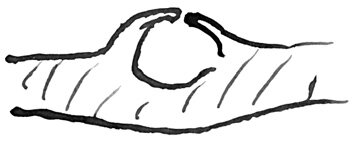From W. G. Smith 27 July 1877
15, Mildmay Grove, N.
27 July 1877
My dear Sir
It was very kind of you to request your publisher to forward me a copy of your “Forms of Flowers” & I return you my best thanks for the book—1 It of course has an additional value in my eyes as coming from you for I have long been a careful & admiring student of your excellent works.—
During intervals of other work I have carefully looked over the Sea-Kale & Iris leaves— My son has also carefully looked over them & the conclusion arrived at is, that the decayed spots are not due to fungus-work2
Various fungi are common on the Cruciferæ but no fungus known to me leaves a scar in any way resembling the scars on your leaves— Some of these scars (where the epidermis has not yet decayed away) are thus in section

& I take the small orifice to be the hole from which some very small larva has emerged— Various eggs & other traces of small beetles, flies &c (?) were on the leaf— The fine mildew on some of the spots is an after-growth. I do not think the raised & brown border round the depressions tells against insect work for as far as my experience goes, this thickening is not uncommon after the bites & punctures of insects & the gnawings of larvæ— As a case in point I have just engraved a Cattleya leaf for G. Chron. punctured all over by some fly (to be described by Westwood) & every puncture is surrounded by a thickening of the cells thus in section.—3

Above remarks also apply to Iris:— I can see neither spores or threads & nothing that at first sight reminds me of a fungus—or fungus-work I am inclined to consider the elongated spots to be due to the gnawings of some larvā & the smaller stains as caused by the puncture of some insect
The bloom on the 2 plants sent me appears to protect the leaves against the attacks of larvæ (& probably mites ⟨ ⟩)
Some botanists have thrown out a suggestion to the effect that hairs may possibly protect some plants from the attacks of fungus-spores, but I do not think hairy plants are so protected—there is such a great difference in size between hairs & spores or even fungus-threads—
Yours faithfully | W. G. Smith
Chas Darwin Esq | F.R.S.
Footnotes
Bibliography
Forms of flowers: The different forms of flowers on plants of the same species. By Charles Darwin. London: John Murray. 1877.
Summary
Has examined some sea-kale and iris leaves sent by CD and does not think the scars are caused by fungus but rather through the action of insects. Feels "bloom" may protect leaves from such insect attack.
Letter details
- Letter no.
- DCP-LETT-11075
- From
- Worthington George Smith
- To
- Charles Robert Darwin
- Sent from
- London, Mildmay Grove, 15
- Source of text
- DAR 177: 202
- Physical description
- ALS 4pp damaged
Please cite as
Darwin Correspondence Project, “Letter no. 11075,” accessed on


